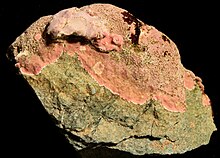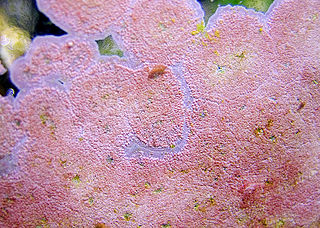
Coralline algae are red algae in the order Corallinales. They are characterized by a thallus that is hard because of calcareous deposits contained within the cell walls. The colors of these algae are most typically pink, or some other shade of red, but some species can be purple, yellow, blue, white, or gray-green. Coralline algae play an important role in the ecology of coral reefs. Sea urchins, parrot fish, and limpets and chitons feed on coralline algae. In the temperate Mediterranean Sea, coralline algae are the main builders of a typical algal reef, the Coralligène ("coralligenous"). Many are typically encrusting and rock-like, found in marine waters all over the world. Only one species lives in freshwater. Unattached specimens may form relatively smooth compact balls to warty or fruticose thalli.
The history of phycology is the history of the scientific study of algae. Human interest in plants as food goes back into the origins of the species and knowledge of algae can be traced back more than two thousand years. However, only in the last three hundred years has that knowledge evolved into a rapidly developing science.

Conceptacles are specialized cavities of marine and freshwater algae that contain the reproductive organs. They are situated in the receptacle and open by a small ostiole. Conceptacles are present in Corallinaceae, and Hildenbrandiales, as well as the brown Fucales. In the Fucales there is no haploid phase in the reproductive cycle and therefore no alternation of generations. The thallus is a sporophyte. The diploid plants produce male (antheridia) and female (oogonia) gametangia by meiosis. The gametes are released into the surrounding water; after fusion, the zygote settles and begins growth.
Wataru Ishijima was a paleontologist and geologist. Ishijima was one of the most prolific researchers of fossil calcareous algae. After graduating from the Imperial Fisheries Institute in 1927, Ishijima joined the Institute of Geology and Paleontology, Faculty of Science, Tohoku Imperial University (Sendai) from 1927–1931. He then worked at the Institute of Geology, Taihoku Imperial University (Taipei) during 1942–1945 and then at the Rikkyo University (Tokyo) from 1945–1980. His doctoral dissertation was submitted to Tohoku University and was privately published by Yūhodō. He described a total of 139 taxa of fossil calcareous algae including at least 114 species of Corallinales, and he produced more than 45 publications on coralline algal taxonomy.

The Corallinaceae are one of the two extant Coralline families of red algae; they are differentiated from the morphologically similar Sporolithaceae by their formation of grouped sporangial chambers, clustered into sori. The Corallinoideae is monophyletic; the other subfamilies form another monophyletic group.
Phymatolithon is a genus of non geniculate coralline red algae, known from the UK, and Australia. It is encrusting, flat, and unbranched; it has tetrasporangia and bisporangia borne in multiporate conceptacles. Some of its cells bear small holes in the middle; this distinctive thallus texture is termed a "Leptophytum-type" thallus surface, and has been posited as a taxonomically informative character. It periodically sloughs off its epithallus, reducing its overgrowth by algae by as much as 50% compared to bare rock.
The Rhodogorgonales are an order of red algae, a sister group to the corallines. They are always thalloid and calcified; their calcification is very different from the corallines, as individual calcite crystals are deposited in the cell wall of specialised cells; this suggests that the evolution of calcification may have been independent from the corallines. They have no fossil record.
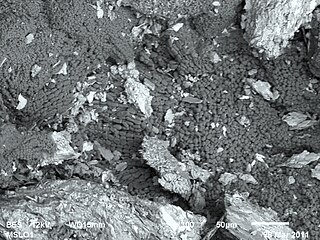
Lithophyllum is a genus of thalloid red algae belonging to the family Corallinaceae.
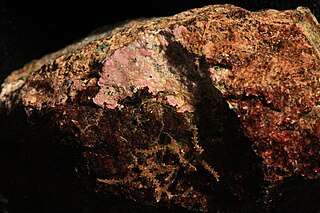
Hildenbrandia is a genus of thalloid red alga comprising 26 species. The slow-growing, non-mineralized thalli take a crustose form. Hildenbrandia reproduces by means of conceptacles and produces tetraspores.
The Sporolithaceae are one of the two extant families of coralline algae. They are differentiated from the other family, the Corallinaceae, by their formation of conceptacles with one or many pores.
The Mastophoroideae are a subfamily of Corallinaceaen coralline algae with uniporate conceptacles.

The Lithophylloideae are a monophyletic subfamily of Corallinaceaen Coralline algae with uniporate conceptacles.
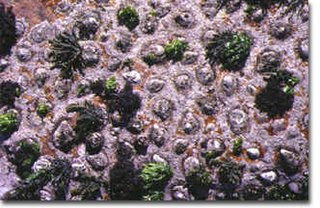
Spongites yendoi is a species of crustose red seaweed with a hard, calcareous skeleton in the family Corallinaceae. It is found on the lower shore as part of a diverse community in the southeastern Atlantic Ocean and the Indo-Pacific Ocean.

Melobesia membranacea is a small marine alga encrusting on the surface of other algae. In the division of the Rhodophyta.

Michael Dominic Richard Guiry, is an Irish botanist, who specialises in phycology (algae). See for example the articles. He is the founder and director of the algal database, AlgaeBase.
Sporolithon ptychoides is a species of crustose red seaweed with a hard, calcareous skeleton in the family Corallinaceae. It has a widespread distribution, being present in the Pacific and Indian Oceans, the Mediterranean Sea and the southwestern Atlantic Ocean.
Lithophyllum incrustans is a small pinkish species of seaweed.
Phymatolithon lenormandii is a common red alga.
Lithothamnion glaciale is the botanical name for a species of multicellular red algae of the genus Lithothamnion, subfamily Melobesioideae.
